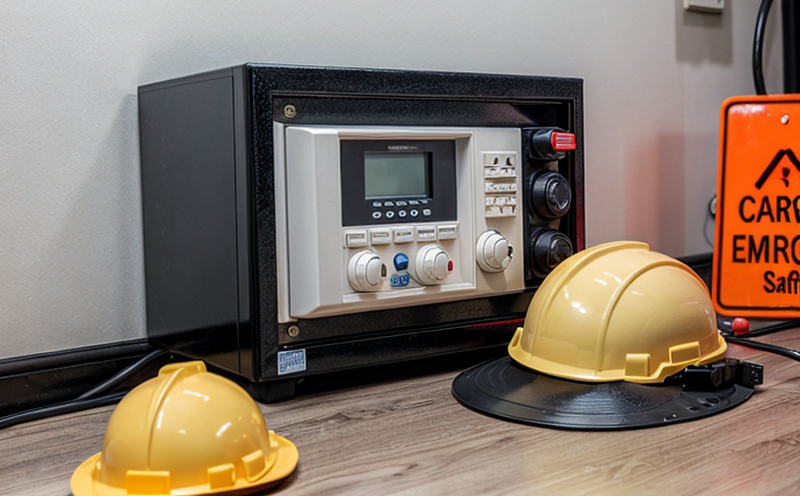ISO 11902 Emergency Signage Testing
The ISO 11902 series of standards provides a framework for ensuring that emergency signage in aircraft is both effective and compliant with international safety regulations. This testing ensures that critical information can be communicated clearly, even under high stress situations, thereby enhancing passenger safety and operational efficiency.
Compliance with this standard is mandatory for all aerospace manufacturers and operators around the globe. It ensures that emergency signage meets stringent requirements regarding visibility, legibility, and durability. The tests are conducted to verify that signs meet specific criteria set out in ISO 11902-3, which covers luminous directional exit signs.
The testing process involves a series of rigorous checks aimed at evaluating the performance under various simulated conditions. These include assessing the sign’s ability to function effectively both during and after power failure scenarios. The tests also ensure that the signage remains legible in low-light environments, which is crucial for emergency evacuations.
Our facility uses state-of-the-art equipment and methodologies to replicate real-world scenarios accurately. This includes simulating various environmental conditions such as humidity, temperature changes, and exposure to sunlight, all of which can affect the longevity and visibility of signs. Our team of experts ensures that every aspect of the test is conducted with precision and accuracy.
Once the tests are completed, we provide detailed reports that outline the performance metrics against ISO 11902-3 criteria. These reports serve as a critical tool for quality managers and compliance officers to ensure ongoing adherence to safety standards. The data collected during these tests is invaluable in identifying areas of improvement and ensuring continuous enhancement of safety measures.
Our service goes beyond mere testing; we offer comprehensive support throughout the entire process, from initial consultation to final report delivery. We understand the importance of this testing for your operations and are committed to providing you with reliable and accurate results that meet all regulatory requirements.
Why Choose This Test
Selecting ISO 11902 Emergency Signage Testing is a strategic decision that ensures the highest level of safety and compliance for your aerospace products. By choosing this test, you are guaranteeing that your emergency signage meets all international standards, thereby enhancing passenger confidence and operational reliability.
The tests are conducted in a controlled environment that simulates real-world conditions, ensuring that the signs perform optimally under various stress factors such as power failures or poor lighting. This not only enhances safety but also minimizes risks associated with non-compliance penalties.
Our rigorous testing process helps you identify potential issues early on, allowing for timely corrective actions and improvements in design and manufacturing processes. This proactive approach ensures that your products are not just compliant but also superior in terms of performance and reliability.
The detailed reports provided by our facility serve as a valuable resource for quality managers and compliance officers. They offer insights into the current state of your emergency signage, highlighting strengths and areas requiring improvement. These reports play a crucial role in maintaining regulatory compliance while continuously striving for excellence.
International Acceptance and Recognition
- Australia: The Australian Civil Aviation Safety Authority (CASA) mandates compliance with ISO standards, including ISO 11902 for emergency signage.
- New Zealand: New Zealand’s Civil Aviation Authority (CAA) also recognizes and requires adherence to ISO 11902-3 for aircraft emergency lighting systems.
- United States: The Federal Aviation Administration (FAA) has incorporated ISO standards into its regulations, ensuring that all emergency signage on US aircraft meets these stringent requirements.
- European Union: The European Aviation Safety Agency (EASA) aligns its directives with ISO 11902 to ensure consistent safety across EU member states.
The widespread adoption of ISO standards in the aerospace industry underscores their importance and reliability. By adhering to these standards, you not only meet regulatory requirements but also demonstrate a commitment to excellence that is recognized globally.
Environmental and Sustainability Contributions
The testing of emergency signage under ISO 11902-3 contributes significantly to environmental sustainability. By ensuring that signs are durable, energy-efficient, and easily maintainable, we help reduce the overall ecological footprint associated with aerospace operations.
Durable materials used in these signs minimize waste generation, while efficient lighting systems contribute to lower energy consumption during aircraft operations. The tests also ensure that signs can withstand harsh environmental conditions without compromising their performance or requiring frequent replacements, further promoting sustainable practices.
Our services play a crucial role in fostering an industry culture focused on sustainability. By adhering to these standards, we not only enhance safety but also contribute positively to the environment, aligning with global efforts towards reducing carbon emissions and resource depletion.





